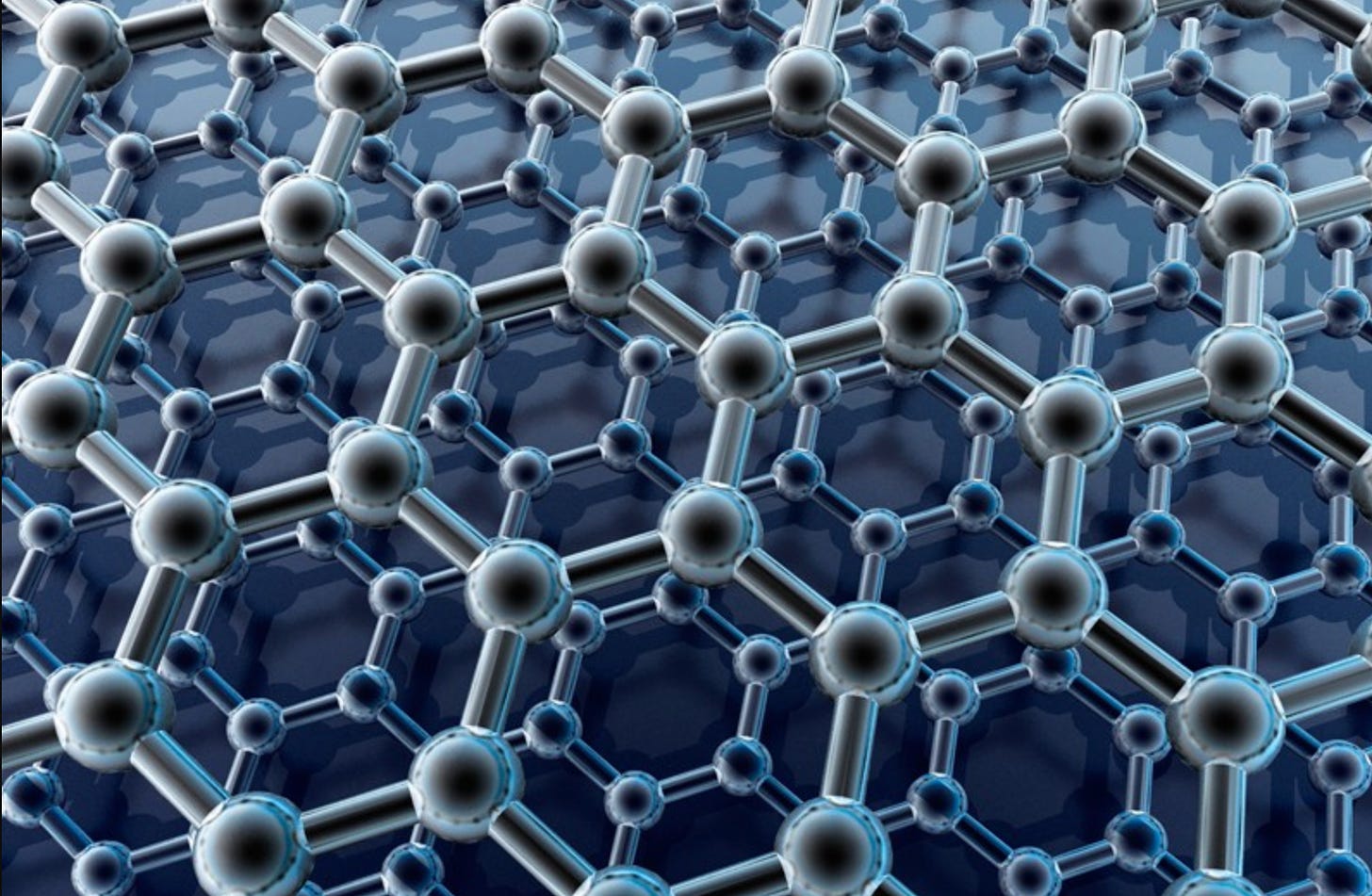Graphene: New Comprehensive Study, Degradation, and Industry Trends
Study from January 2024 talks about avenues of biological harm and degradation of graphene
In case you have not seen it yet, an interesting study about graphene came out recently. It is the most comprehensive study I have seen so far as far as looking into toxicity of graphene. It discusses graphene properties, avenues of biological harm, and—most importantly—degradation of graphene.
Here is the abstract (if you click on the study link, you can click on the Full Text tab):
Graphene-based materials (GBMs) possess remarkable physiochemical properties, making them promising for diverse applications in biomedicine, agriculture, food, and industrial applications. Human and environmental exposure to GBMs is increasing at an unprecedented rate, yet there is still a knowledge gap regarding the safety of GBMs. This review summarizes the physiochemical properties of GBMs and critically examines the possible effects of GBMs, both at the level of molecular mechanism and at the level of the organism. While oxidative stress-mediated cell damage has been proposed as a primary cytotoxicity mechanism for GBMs, various in vivo biodistribution and cytotoxicity mechanisms are also highlighted. This review of the literature provides an overview of the cytotoxicity of GBMs, raising concerns about their widespread application with potential hazardous consequences on the environment and in human health [emphasis mine].
The study has a very helpful section on degradation of graphene-based nanomaterials.
Degradation of Graphene-based Nanomaterials
More research on the environmental fate and biodegradation of GBMs is needed, as their environmental and health impacts are still largely unknown. This lack of current understanding should motivate research into the breakdown of GBMs to address potential environmental toxicity and health hazards.
Humic acid or Shilajit is known to be excellent antidotes to GBNs, by mitigating its acute toxicity by regulating the translocation and metabolic fluxes of GBNs in vivo. Humic acid was found to increase disordered structure and surface negative charges and reduce GBN aggregation. Through immune modulation and reduction of oxidative stress, humic acid also exhibits potent antiviral, antioxidant, and anticarcinogenic properties. Rozhina et al. found that the joint application of GO and kaolin nanoclay reduced the negative cytotoxic effects of graphene by almost 20%. Although Bentonite nanoclay is also recommended as an antidote to graphene-induced cytotoxicity, Di Ianni et al. demonstrated in vitro that pristine Bentonite induced pro-inflammatory responses in alveolar epithelial cells (A549).
Several mechanisms exist by which biological systems degrade GBMs, particularly GO. Human eosinophils produce an enzyme known as eosinophil peroxidase (EPO) in the presence of low concentrations of hydrogen peroxide (H2O2) and sodium bromide (NaBr); EPO can degrade GO [90]. Another enzyme produced by neutrophils in the presence of low concentrations of H2O2 is myeloperoxidase (MPO), which can also degrade GO sheets. Given the roles of human eosinophils and neutrophils, the degradation of GO can be thought to be immune mediated. Still, much is unknown about GBNs in the human body. H2O2 is involved in various redox signal transduction pathways. It is known to exert DNA damage, while aggregated GO sheets did not degrade in the presence of H2O2. Kotchey et al. established that horseradish peroxidase can create holes in GO sheets, while nitric oxide (NO) can also degrade GO.
On the production side, functionalization of GO with the compounds coumarin and catechol increases the efficiency of biodegradation]. In the environmental context, GO can be degraded by light and specific bacteria, such as Labrys sp. WJW, which are also capable of degrading C60, or Buckminsterfullerene. Furthermore, GO can be degraded by adding FeCl3, H2O2 and UV light after ultrasonification and acidification, which presents a promising means of removing GO from wastewater.
Glyphosate 2.0?
Here is the psychological (and biological) kicker. In the medical freedom community, there is a lot of concern about the presence of undeclared graphene and graphene derivatives in COVID vaccines. However, the actual problem is much broader, in my opinion. Graphene is the new asbestos of sorts, or perhaps Glyphosate 2.0—on steroids. It is all the rage right now in multiple industries. A lot of shallow, irresponsible people with influence are salivating over it, and it is likely that we are going to see graphene all over the place more and more.
"Our final goal is seeing graphene and related materials fully integrated in day-to-day products and manufacturing," says Henning Döscher from Graphene Flagship partner Fraunhofer ISI, who leads the Graphene Flagship Roadmap Team… "Graphene and related materials add value throughout the value chain, from enhancing and enabling new materials to improving individual components and, eventually, end products."
Here is a PDF of an article that I wrote for Dr. Mercola in 2022, I recommend you read it if you want to look into different industries that aspire to incorporate graphene.
Here is another 2022 article about a convoluted toxicity study.
And finally, if you have the stomach to keep up to date with graphene industry trends, I recommend this industry website. The trends are more than a little crazy though, so please don’t let it get to you or drive you insane. No craziness lasts forever. We’ll prevail.
A note to readers: If you are in the position to do so, I very much encourage you to become a paid subscriber or donate. I love you in any case, but it helps A LOT, and I am in a dire need to get more donations and paid subscribers while keeping my posts free. Thank you from my heart for your support!





It's funny how graphene was originally promoted as some super tech material that would revolutionize computer chips and electrical things.
It has not performed there.
So they now think it's good for shots?
I do know that graphene ends up in some things because it's used as a lubricant for rubber seals etc in cold temperatures.
Another reason to not get shots...
I'm not sure what exactly do they intend with this tech besides doing what they did before with lipids, aluminum, mercury and other toxic junk in shots...
Be careful when choosing shilijit, there are a lot of scams online. Ascorbic acid, chelation therepy with EDTA, malic acid and a number of other things can also clear graphene oxide as well as the other toxic metals used in the Pegylated nano lipids used to create the mRNA Trojan horse technology. https://secularheretic.substack.com/p/virus-questions-vs-nanotech-realities